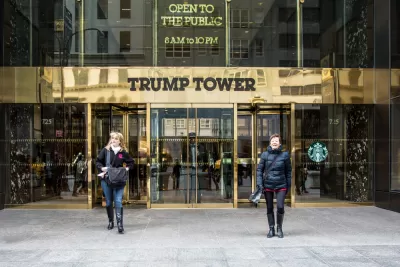Perhaps no development is more associated with the presumptive Republican presidential nominee than Trump Towers, which established his reputation as a developer with little regard for historic preservation and revealed his character in business.

With developer Donald Trump all but certain to be the Republican presidential candidate in November, Planetizen looks at his role as a developer, beginning in 1979, when he acquired the land to build his iconic Trump Towers.
The upscale Bonwit Teller women's department store on Manhattan's Fifth Ave. at 56th Streets opened in 1929. "American Architect magazine called it 'a sparkling jewel in keeping with the character of the store,'" wrote Christopher Gray in the New York Times Streetscapes column on Oct. 3, 2014.
At the very top of the facade were limestone relief panels of two nearly naked women brandishing large scarves, as if dancing. The architects were Whitney Warren and Charles Wetmore, super-traditional Beaux-Arts designers of mansions and clubs — a puzzling choice for a such an outré building. In time the reliefs would become a Bonwit Teller signature.
The relief panels are also referred to as Art Deco friezes or bas-relief sculptures. Gray goes on to describe the company and the store in more detail. "Bonwit Teller closed its store at Fifth and 56th in 1979."
That was good news for Donald Trump, who acquired the old Bonwit’s building and began demolition in 1980. He had promised the limestone reliefs of the dancing women to the Metropolitan Museum of Art, which wanted them for its sculpture collection, although the offer was conditional on his being able to remove them. But suddenly workmen jackhammered them to bits.
"It was a sin deemed unforgivable by landmark preservationists," wrote Marilyn Bender for The New York Times on August 7, 1983.
"Athough he later expressed 'regret' for the demolition, Trump took pains to point out that the negative coverage created free publicity and helped him sell apartments," wrote
“Bonwit Teller established him as a bad guy,” said Kent Barwick, then chairman of New York’s Landmarks Preservation Commission. “Afterwards, rightly or wrongly, there was a question of trust.”
A few years later, he stripped his name across Trump Tower on famously elegant Fifth Avenue, alongside Tiffany & Co., appalling those who viewed his glass high-rise as the equivalent of sticking a gold tooth in Queen Elizabeth’s smile.
One final Trump development to mention, one which he had to compromise in the mid 1980s. Former Planetizen contributor Roberta Brandes Gratz comments on what what have been Trump's tallest buildings.
"Whatever goodwill New Yorkers felt toward Trump was mixed with the fury he provoked with plans to build a wall of skyscrapers that would include the world’s tallest building — 150 stories — on Manhattan’s West Side waterfront," writes Schwartzman.
“I looked at this monster and I knew this was the death knell,” recalled Roberta Gratz, a leader of the opposition who writes about architecture.
Instead of 150 stories, he agreed to build nothing more than 48 floors and add a 21-acre park, setting the stage for a 13-block development that some in the neighborhood still refer to acidly as Trumpistan long after the developer sold his stake.
FULL STORY: Donald Trump's Legacy as a Developer

Alabama: Trump Terminates Settlements for Black Communities Harmed By Raw Sewage
Trump deemed the landmark civil rights agreement “illegal DEI and environmental justice policy.”

Study: Maui’s Plan to Convert Vacation Rentals to Long-Term Housing Could Cause Nearly $1 Billion Economic Loss
The plan would reduce visitor accommodation by 25% resulting in 1,900 jobs lost.

Why Should We Subsidize Public Transportation?
Many public transit agencies face financial stress due to rising costs, declining fare revenue, and declining subsidies. Transit advocates must provide a strong business case for increasing public transit funding.

Wind Energy on the Rise Despite Federal Policy Reversal
The Trump administration is revoking federal support for renewable energy, but demand for new projects continues unabated.

Passengers Flock to Caltrain After Electrification
The new electric trains are running faster and more reliably, leading to strong ridership growth on the Bay Area rail system.

Texas Churches Rally Behind ‘Yes in God’s Back Yard’ Legislation
Religious leaders want the state to reduce zoning regulations to streamline leasing church-owned land to housing developers.
Urban Design for Planners 1: Software Tools
This six-course series explores essential urban design concepts using open source software and equips planners with the tools they need to participate fully in the urban design process.
Planning for Universal Design
Learn the tools for implementing Universal Design in planning regulations.
Caltrans
Smith Gee Studio
Institute for Housing and Urban Development Studies (IHS)
City of Grandview
Harvard GSD Executive Education
Toledo-Lucas County Plan Commissions
Salt Lake City
NYU Wagner Graduate School of Public Service


























